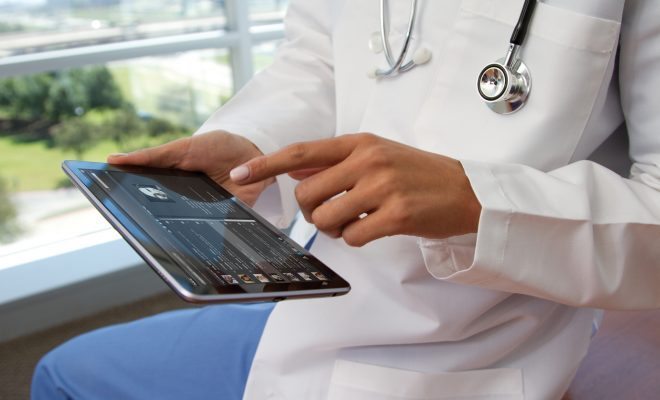 Image courtesy of [NEC Corporation of America with Creative Commons license via Flickr]
Image courtesy of [NEC Corporation of America with Creative Commons license via Flickr]
Health & Science
Big Data: A Revolution for Women’s Healthcare
Sponsored Content
Since 1990, the Society for Women’s Health Research (SWHR®) has been advocating for innovation in women’s healthcare. The organization is on the cutting edge of the newest research trends, and each year SWHR picks a different theme to highlight at its annual gala. At this year’s event, one message rang loud and true: we’re officially in the age of big data. Almost everything we do–from voting choices, to commercial purchases, to Netflix binge-watching, can be recorded and analyzed to glean patterns. But the incorporation of big data into healthcare is particularly exciting, and promises to revolutionize medical treatment for women. Read on for a sampling of how we’re now integrating big data into patient treatments, and what it means for women’s health.
Big Data & Women’s Health
First Things First: What exactly is big data?
It’s a fair question. We hear the term thrown around a lot, but there’s certainly no cut and dry definition. Essentially, big data is the collection and use of large amounts of information that are naturally generated from our everyday activities. Big data and healthcare can include things like our use of smartphones (and other technology like FitBit or the Apple Watch) to track our fitness levels, the prescriptions we are given, the information generated by clinical trials, the analysis of our genetic material, and so much more.
So how can big data affect women’s health?
It’s no secret that there are sex differences in health. Medical research has only recently begun to recognize these differences and incorporate them into the diagnosis and treatment of illnesses. While our understanding of sex differences and how they affect health have improved, discoveries are still being made about the different ways that certain diseases and treatments affect women. The ability to collect data and pinpoint patterns specifically for women will help inform how to treat them moving forward.
Big Data in Action
Take for example, a project at Baystate Medical Center, in Massachusetts–the Breast Cancer Registry. Researchers there are creating a large database based on data collected from 400 women who have had breast cancer. The data will help the researchers find patterns in how different women respond to treatments, by acknowledging factors like genetics, age, weight, lifestyle, and other aspects of health. According to Dr. Grace Makari-Judson, chair of the Baystate Health Breast Network and co-director of the Rays of Hope Center for Breast Cancer Research:
What’s nice about the experience with the registry, we have a diverse group of individuals participating and they aren’t the highly selected people in clinical trial. You get more meaningful data (looking at) what is the use of this drug like in the general population.
The inclusion of women (especially minority women) into clinical trials has been a long fought battle, so the ability to collect and analyze this kind of data in the real world is invaluable.
Electronic Health Records
Electronic health records are another innovative way to use the data already at our disposal. To many, it probably seems archaic that until recently, almost all of our medical information was kept in file folders. We now have the technology to process and incorporate massive amounts of data on patients–from childhood illnesses and injuries to family histories and genetic information.
As electronic health records start being implemented, evidence has begun to show that these records help doctors more effectively manage women’s health. A report in the Journal of the Medical Informatics Association showed that the presence of electronic health records make it more likely that doctors order essential tests like pap smears and breast exams for their female patients–leading to an overall positive impact on women’s health.
Examples of Individual Applications
Genomics
Genomics is the practice of mapping an individual’s genetic material. It’s a data-intensive process that requires serious computing power. Genomics can help provide patients with a predictive and more individual picture of their health. For women, one of the most visible developments in the field of genomics is the ability to test BRCA1 and BRCA2. Certain genetic mutations in those genes greatly increase the risk of ovarian and breast cancer. According to the National Cancer Institute:
Together, BRCA1 and BRCA2 mutations account for about 20 to 25 percent of hereditary breast cancers and about 5 to 10 percent of all breast cancers. In addition, mutations in BRCA1 and BRCA2 account for around 15 percent of ovarian cancers overall. Breast and ovarian cancers associated with BRCA1 and BRCA2 mutations tend to develop at younger ages than their nonhereditary counterparts.
In cases where BRCA1 and BRCA2 mutations exist, steps like enhanced screening, chemoprevention (the use of drugs to reduce the likelihood of or delay the onset of cancer), or preventative surgery might be considered. For example, actress and filmmaker Angelina Jolie tested positive for a BRCA1 mutation, and as a result chose to get a double mastectomy in 2013.
Precision Medicine
Precision medicine is an exciting new development that ties a lot of the tenets of big data together. Precision medicine uses big data, as well as other tools like genomics, to create more individualized treatment for patients. The Obama Administration has spearheaded the precision medicine initiative, and explains the aim in a press release:
The future of precision medicine will enable health care providers to tailor treatment and prevention strategies to people’s unique characteristics, including their genome sequence, microbiome composition, health history, lifestyle, and diet. To get there, we need to incorporate many different types of data, from metabolomics (the chemicals in the body at a certain point in time), the microbiome (the collection of microorganisms in or on the body), and data about the patient collected by health care providers and the patients themselves. Success will require that health data is portable, that it can be easily shared between providers, researchers, and most importantly, patients and research participants.
Conclusion
The expanded use of data in healthcare is the future, and the developments that we’re seeing in the present are already incredibly exciting. As SWHR puts it:
Data initiatives are revolutionizing healthcare and helping to improve every aspect of medicine, from bench to bedside. This data, which is being collected and utilized by healthcare providers, pharmaceutical and medical device companies, insurance companies, hospitals, and researchers, provides a wealth of healthcare information that can be used to better inform healthcare decisions and delivery for every woman.
Resources
Primary
SWHR: SWHR’s 26th Annual Gala: “Revolutionizing Healthcare & Research Through Data”
National Cancer Institute: BRCA1 and BRCA2: Cancer Risk and Genetic Testing
The White House: The Precision Medicine Initiative
Additional
Law Street Media: Precision Medicine: The Future of Health Care?
CB Insights: 13 Startups Working in Women’s Reproductive Health
Forbes: How Big Data is Changing Healthcare
Boston Business Journal: Focus on Women’s Health: Big Data, Registries Help Docs Understand Cancer
Radar: Genomics and the Role of Big Data in Personalizing the Healthcare Experience
New York Times: Angelina Jolie; My Medical Choice
Modern Healthcare: EHR Use Tied to More Women’s Health Tests: Study








Comments